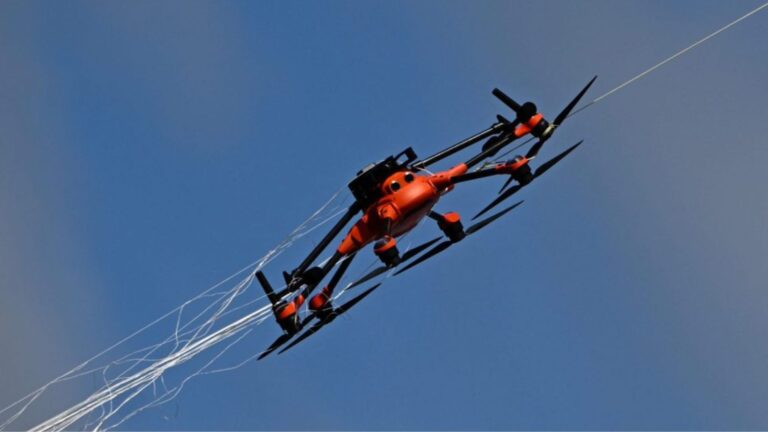
Denmark’s armed forces reported fresh drone sightings over military installations early Sunday morning, marking the seventh consecutive day of unexplained aerial activity that has prompted authorities to implement a nationwide ban on civilian drone flights and mobilize NATO support. The Danish Defense Ministry confirmed multiple unidentified drones were detected at several military facilities overnight Saturday into Sunday, deploying “several capabilities” in response while declining to specify exact locations or the number of aircraft involved.
Escalation Prompts International Response
The latest incidents occurred just hours before Denmark imposed a five-day prohibition on civilian drone operations, effective Monday through Friday this week, as the country prepares to host European Union leaders for a summit in Copenhagen. The ban coincides with Denmark’s role as the rotating EU president and comes as German air defense frigate FGS Hamburg arrived in Copenhagen Sunday to bolster airspace monitoring.
NATO announced Saturday it would enhance its Baltic Sea operations under “Baltic Sentry,” deploying additional intelligence, surveillance, and reconnaissance platforms along with at least one air-defense frigate to the region. The alliance’s response follows a request from Danish officials and builds upon existing NATO operations launched after sabotage incidents involving Baltic Sea cables.
“We are currently in a difficult security situation, and we must ensure the best possible working conditions for the Armed Forces and the Police when they are responsible for security during the EU summit,” Defense Minister Troels Lund Poulsen stated Sunday.
Pattern of Professional Operations
The drone incidents began September 22 with a nearly four-hour closure of Copenhagen Airport after multiple large drones were spotted in controlled airspace. Since then, five Danish airports have experienced temporary shutdowns, including Aalborg Airport, which serves both civilian and military operations. Friday’s sightings at Karup Air Base, Denmark’s largest military facility housing 3,500 personnel and the country’s helicopter fleet, forced brief civilian airspace restrictions around 8 p.m. local time.
Danish Defense Minister Troels Lund Poulsen characterized the activities as the work of a “professional actor” conducting “systematic” operations, while Justice Minister Peter Hummelgaard stated the goal is to “sow fear and division”. Prime Minister Mette Frederiksen called the incidents “the most serious attack on Danish critical infrastructure to date,” though officials stress there is no direct evidence linking the activities to Russia. The Russian Embassy in Denmark has denied involvement in the incidents.
Military Installations Under Surveillance
Saturday’s overnight incidents specifically targeted Skrydstrup Air Base and the Jutland Dragoon Regiment base, according to the Defense Ministry. Local media reported additional drone activity at Karup Air Base, though military officials declined to confirm specific details citing operational security concerns. The base shares its runways with civilian operations and serves as headquarters for Denmark’s helicopter operations, airspace monitoring, and flight training programs.
“For reasons of operational security and the ongoing investigation, the Defence Command Denmark does not wish to elaborate further on drone sightings,” the ministry stated. Police reported they were unable to determine the origin of the drones and confirmed they had not intercepted any of the aircraft.
Regional Security Concerns
The drone incidents extend beyond Denmark’s borders, with similar activities reported in Norway, Lithuania, and Finland during the same timeframe. Norwegian authorities investigated possible drone sightings near Orland airbase, which houses the country’s F-35 fighter jets, while Lithuania reported three drones near Vilnius airport causing commercial flight delays.
These developments coincide with increased Russian airspace violations across Europe, including MiG-31 jets entering Estonian airspace over the Gulf of Finland on September 19. German officials also reported Russian reconnaissance aircraft conducting low-altitude overflights of the frigate Hamburg while participating in NATO’s Neptune Strike exercise in the Baltic Sea.
Summit Security Preparations
Denmark’s comprehensive response includes hosting crucial European meetings this week, with an informal EU summit Wednesday followed by the broader 47-member European Political Community summit Thursday. The European Political Community, established in 2022 to connect EU and allied European nations following Russia’s invasion of Ukraine, will convene its seventh summit in Copenhagen.
“We cannot accept that foreign drones create uncertainty and disruption in society as we have experienced recently,” Transport Minister Thomas Danielsen stated. The violation of the drone ban could result in fines or imprisonment for up to two years.
NATO’s Enhanced Baltic Presence
NATO’s Baltic Sentry mission expansion represents a significant escalation in regional security measures, building on operations initially launched to protect undersea infrastructure following suspected sabotage incidents. The enhanced mission includes intelligence, surveillance, and reconnaissance platforms alongside air-defense frigates to monitor the strategic Baltic Sea region.
The alliance’s response demonstrates unified concern over hybrid warfare tactics and infrastructure vulnerabilities across northern Europe. Since 2022, approximately ten subsea cables connecting Baltic nations have been severed, with seven incidents occurring between November 2024 and January 2025.
Danish authorities continue investigating the drone incidents while maintaining heightened security measures throughout the critical diplomatic period, emphasizing their commitment to protecting both national infrastructure and international partners during this unprecedented aerial campaign.











